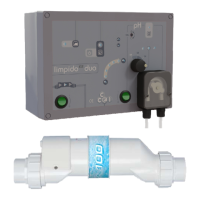
Do you have a question about the ccei Limpido EZ DUO 60 and is the answer not in the manual?
| Power | 60W |
|---|---|
| Frequency | 50/60Hz |
| Beam Angle | 120° |
| IP Rating | IP20 |
| Color Temperature | 3000K |
| Material | Aluminum |
Lists the items included with the Limpido EZ Duo system.
Explains the process of salt electrolysis for water sterilization and chlorine production.
Details pH measurement, its impact on water quality, and ideal ranges for pool water.
Describes the electrolysis cell, its material, and design for service life.
Explains the flow detector's role in ensuring safe electrolyser operation.
Details the pH probe, its function, and handling requirements.
Instructions for correctly mounting the pH probe in the system.
Guidance on placing the product injector after the pH probe.
Steps for mounting the flow detector with correct orientation.
Explains connecting the cover contact for automatic production adjustment.
Details how the system forces filtration for adequate production time.
Information on connecting external programmers or measuring devices.
Safety guidelines for power supply, protection, and installation location.
Guides on verifying and adjusting the pool's salt content for optimal performance.
Explains the role of cyanuric acid as a chlorine stabiliser.
Recommends testing Total Phenolphthalein Alkalinity and Total Hardness.
Step-by-step guide for calibrating the pH probe using standard solution.
Explanation of the device's indicator lights and control buttons.
Details on selecting Shock/Permanent or Automatic/Thermoregulated modes.
How to select and save thermoregulation curves for automatic operation.
Describes device behavior and faults related to low temperatures.
Explains the polarity reversal indicator lights for cell maintenance.
Details how indicator lights show the production level and potential issues.
Explains causes and solutions for overproduction and underproduction alerts.
Describes the meaning of pH indicator lights for dosing pump status.
How to select the desired pH setpoint value using the rotary switch.
Information on the overdose indicator and injection limits.
Guidelines for maintaining the pH probe's accuracy and lifespan.
Recommendations for operating the device in cold weather conditions.
Instructions for adding salt and tables for required amounts based on volume.
Procedure for cleaning the electrolysis cell plates when production is low.
